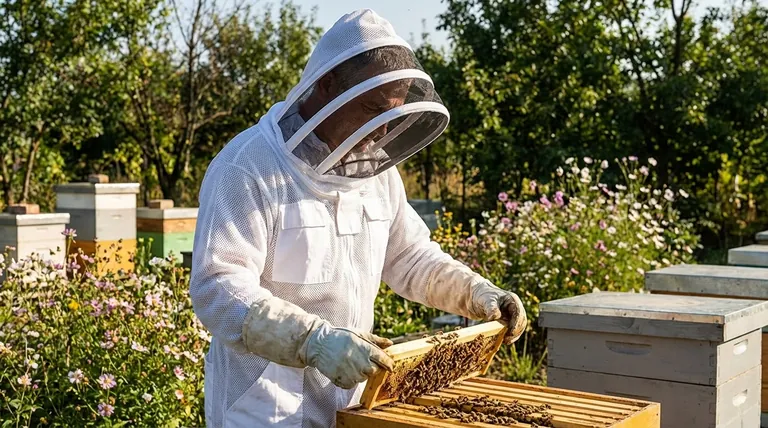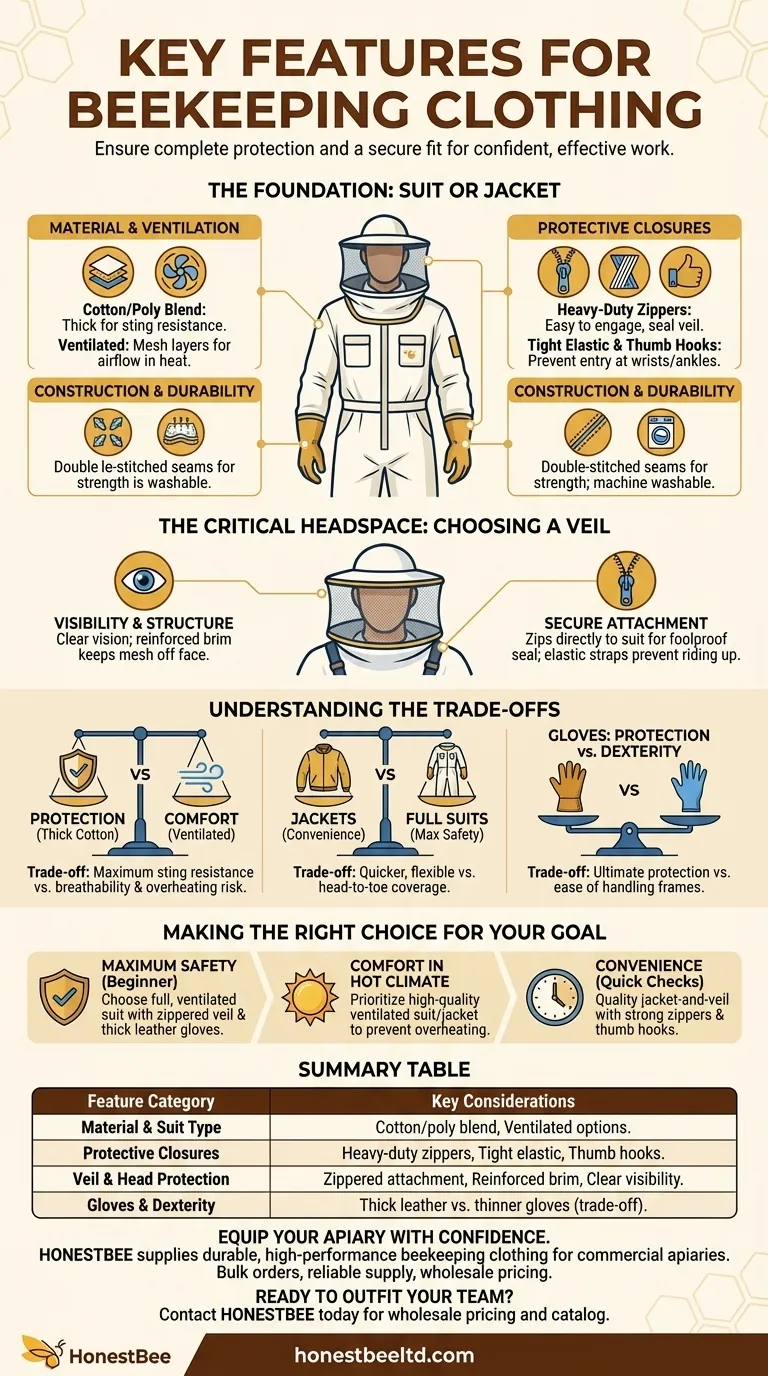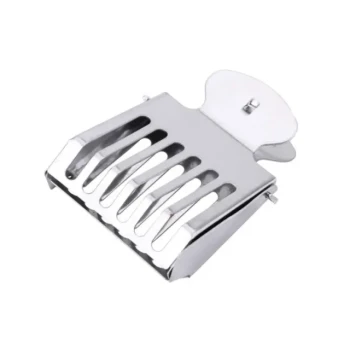When choosing beekeeping clothing, the most critical features are those that ensure complete protection and a secure fit. Look for light-colored, durable materials with strong closures like zippers and tight elastic at the wrists and ankles. A well-designed veil that keeps mesh away from your face is non-negotiable, and practical additions like thumb hooks and tool pockets enhance usability.
The goal of beekeeping clothing is not just to prevent stings, but to give you the confidence to work calmly and effectively. The best gear achieves this by creating an impenetrable barrier against bees while prioritizing comfort, visibility, and ease of use.

The Foundation: The Suit or Jacket
The largest piece of your protective gear, the suit or jacket, forms the core of your defense. Its design directly impacts your safety and comfort during hive inspections.
Material and Ventilation
The fabric of your suit is your first line of defense. Most suits are made from a thick cotton or a poly-cotton blend that is difficult for a bee's stinger to penetrate.
While thickness provides protection, it can be extremely hot. Ventilated suits or jackets, which feature layers of mesh, offer a critical advantage in warm climates by allowing for airflow without compromising safety.
Protective Closures
How a suit seals is as important as the material itself. Look for heavy-duty zippers that are easy to engage, especially the one connecting the veil to the suit.
Tight elastic around the ankles and wrists is essential to prevent bees from crawling inside. For an even more secure seal, some jackets include thumb hooks that keep the sleeve firmly tucked inside your gloves.
Construction and Durability
A quality suit is an investment that should last for many seasons. Check for double-stitched seams, which provide superior strength and prevent rips under stress. Machine washability is also a key feature for easy maintenance.
The Critical Headspace: Choosing a Veil
Your face and neck are the most vulnerable areas, making the veil the single most important piece of protective equipment.
Visibility and Structure
A good veil must provide clear, unobstructed vision. It should also have a reinforced brim or internal structure that holds the mesh screen away from your face and neck at all times, even when you bend over.
An attack from a defensive bee can easily push a flimsy veil against your skin, enabling a sting.
Secure Attachment
The most secure veils zip directly onto the jacket or suit, creating a foolproof seal. Other styles may use drawstrings, but these can leave small gaps if not secured perfectly.
Many veils also include elastic shoulder straps to hold the lower portion of the mesh securely against your body, preventing it from riding up.
Understanding the Trade-offs
Choosing the right gear involves balancing competing priorities. Understanding these trade-offs will help you select equipment that fits your specific needs.
Protection vs. Breathability
Thicker, non-ventilated cotton offers maximum sting resistance but can lead to overheating, which increases your risk of making mistakes. Ventilated suits significantly improve comfort but may feel less substantial to a new beekeeper.
Jackets vs. Full Suits
A full suit offers complete, head-to-toe protection and is the recommended choice for beginners, as it eliminates the potential for a gap at the waist. A jacket is quicker to put on for fast inspections and offers more flexibility, but you must ensure you are wearing thick pants and that the seal at your waist is secure.
Gloves: Dexterity vs. Protection
Thick leather gloves offer the ultimate protection but can make it difficult to handle frames and queens delicately. Thinner goatskin or nitrile-coated gloves improve dexterity but offer less sting resistance. Many beekeepers start with thick gloves and move to thinner ones as their confidence grows.
Making the Right Choice for Your Goal
Your ideal gear depends on your climate, experience level, and the temperament of your bees.
- If your primary focus is maximum safety as a beginner: Choose a full, ventilated bee suit with zippered attachments for the veil and a pair of thick leather gloves.
- If your primary focus is comfort in a hot climate: Prioritize a high-quality ventilated suit or jacket to prevent overheating during inspections.
- If your primary focus is convenience for quick hive checks: A quality jacket-and-veil combination with strong zippers and thumb hooks offers a great balance of protection and speed.
Ultimately, the right clothing is the gear that makes you feel secure, allowing you to become a calm and confident beekeeper.
Summary Table:
| Feature Category | Key Considerations |
|---|---|
| Material & Suit Type | Cotton/poly blend for durability; Full suit (max safety) vs. Jacket (convenience); Ventilated options for hot climates. |
| Protective Closures | Heavy-duty zippers; Tight elastic at wrists/ankles; Thumb hooks to secure sleeves. |
| Veil & Head Protection | Zippered attachment to suit; Reinforced brim to keep mesh off face; Clear visibility is critical. |
| Gloves & Dexterity | Trade-off: Thick leather (protection) vs. thinner gloves (dexterity). Choose based on experience. |
Equip Your Apiary with Confidence
Protecting your beekeepers is an investment in the productivity and safety of your entire operation. HONESTBEE supplies durable, high-performance beekeeping clothing and equipment designed for the demands of commercial apiaries and distributors.
We understand that your needs for bulk orders, reliable supply, and wholesale pricing are unique. Our focus is on providing the protective gear that keeps your teams safe and efficient, season after season.
Ready to outfit your team with gear that balances maximum protection with essential comfort?
Contact HONESTBEE today for wholesale pricing and catalog to discuss your specific requirements.
Visual Guide

Related Products
- 3 Layer Mesh Vented Sting Proof Beekeeping Suit with Hat and Veil
- Cotton Beekeeping Suit and Round Hat with Veil Bee Keeper Protective Gear
- Vented Beekeeping Jacket with Hood and Veil for Beekeepers
- Yellow Plastic Bucket Pail Perch for Beekeeping
- Heavy-Duty Stainless Steel Clip-On Frame Perch
People Also Ask
- What are the advantages of reinforced stitching and durable zippers in beekeeping suits? Ensure Maximum Safety & Longevity
- What features should be considered for sting protection in a beekeeping suit? Ensure Total Safety and Comfort
- What should be worn under beekeeping protective clothing? Maximize Your Safety with the Right Base Layer
- Why do beekeepers wear suits? Essential Protection for Hive Management
- What protective clothing do beekeepers wear? Essential Gear for Safe & Effective Beekeeping



















